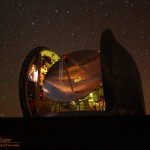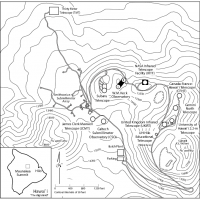One of the most pervasive claims surrounding the summit is that there are obsolete and abandoned telescopes littering the summit region. The claim seems to be pushed to show that there is no need for a new telescope or that the university’s management of the summit is negligent.
There are currently thirteen telescope facilities. All of these telescopes are functional, or were usable scientific instruments prior to shutdown, none have been abandoned in any sense.
Two of the telescopes are currently shutdown, in many ways victims of the current controversy rather than obsolescence. Both could be brought back on-line to perform useful science if allowed.
The Caltech Submillimeter Observatory, or CSO, was shutdown and is now awaiting dismantling and site restoration. An environmental assessment and a conservation district use permit are in process to allow this to happen.
Even while CSO has been shut down the reasons were budgetary, not so much obsolescence. The telescope itself is planned to be dismantled, moved, and reassembled on another site elsewhere in the world.
The University of Hawaii Hoku Kea telescope was due to be recommissioned with a new telescope installed in the recently renovated dome. This is on hold due to the TMT issues and the dome is likely to be dismantled as part of the deal to allow TMT. Loss of this telescope is unfortunate as this was a student telescope for university astronomy students.
Given the actual status of these two shutdown telescopes it is clear they are not abandoned as per the usual claim. All of the other facilities on the summit are operational and doing science.
A major reason for pushing this myth is the requirement to decommission five telescopes in exchange for building TMT. By insisting that these five telescopes are obsolete or useless the protesters devalue the offer and can insist that the state is not negotiating anything of value. This is in line with the standard protest tactic of delegitimizing the state and university.
As these five are all valuable instruments the offer is quite valid, even painful in giving up the very scientifically productive UKIRT and the student telescope Hoku Kea. This demonstrate the state’s willingness to negotiate in good faith while the protesters offer nothing, or even admit they are offering nothing.
Part of this myth is that the abandoned facilities will need to be removed at the expense of the taxpayers of Hawaii. This part is also completely false. The only telescopes that might be removed at the expense of the state are those that were built by the State of Hawaii such as Hoku Kea.
Each of the existing observatories has in place a legally binding agreement with the State of Hawaii that upon decommissioning the facility must be dismantled and the site restored. These agreements require that funding to accomplish this be identified and available either in a bond or a set aside budget.
Another common claim is that a telescope has never been removed or decommissioned. Many opponents seem to be unaware that two telescopes that were built in the early years of astronomy on Mauna Kea have been decommissioned and removed. The Lowell Observatory Planetary Patrol telescope was erected in 1967 and removed in the 1990’s, it was located near the current Gemini Observatory.
There is a requirement to remove five telescopes as part of the permit for the Thirty Meter Telescope. Those five will be the two already shutdown and awaiting decommissioning as well as three more. All of those three are currently operational and doing science.
Another past telescope, now removed was one of the first atop the mauna, placed on Puʻu Poliahu by Gerard Kuiper and the University of Arizona. Nothing remains of this telescope now other than a fading road scar on the slopes of the puʻu. There were other small site test telescopes used during the early years, but these were not substantial and did not require much effort to remove.
A variation of this is that the number of telescope will forever keep growing and that development will continue to expand at the summit.
…More telescopes will be built and none will be decommissioned unless the conservation district laws and rules are changed and the BLNR requires decommission and removal. At the very least, why couldn’t the existing telescopes be removed prior to the start of construction of TMT? Unfortunately and sadly, TMT will be built but we must change the process to not allow any more and to remove all other structures on Mauna Kea…
Pono in a Civil Beat Comment, 17July2019
Anyone familiar with the legal documents governing the summit will be aware that this is completely false. Plans in the 1970’s and 1990’s clearly indicated the allowable area used for telescope facilities, limiting the sites available. The TMT site at 13N is one of the sites identified in these plans. These restrictions were adopted and formalized by the current Mauna Kea Comprehensive Management Plan, permanently limiting development on the mauna.
Some opponents have repeatedly mentioned past promises that “this is the last telescope” were made during older telescope construction. These claims seem to be urban myths, repeated from old memories with no such claims in the written record. Best guess is that this claim is a distortion of the very real site limits in the management plans. The only sites available for future telescopes would be the long ago identified 13N site to be used by TMT or reuse of an existing telescope site.
Result: Mostly False




CSO was shut down in 2015. UKIRT has been on deathwatch since 2009. Tell us again how these aren’t obsolete.
As for the promises made about the telescopes being the last, please look at Clinic, William S. (2020): Understanding Mauna Kea: A Primer on Cultural and Environmental Impacts (preprint available on figshare), which details the promises made and broken by the astronomers.
You are confusing budget issues for obsolescence, the observatory continues to be highly scientifically productive despite budget woes.
I have read the document you note, it a is a ridiculously cherry picked version of events that serves only to distort the conversation and create confrontation.
Yes, it is so terrible when the sins of the astronomers are laid out like that, isn’t it?
The simple truth is that if the astronomers had obeyed the law in the first place and not broken their word in the second place, much of this would be moot. But they did neither and are now reaping the benefit of that.